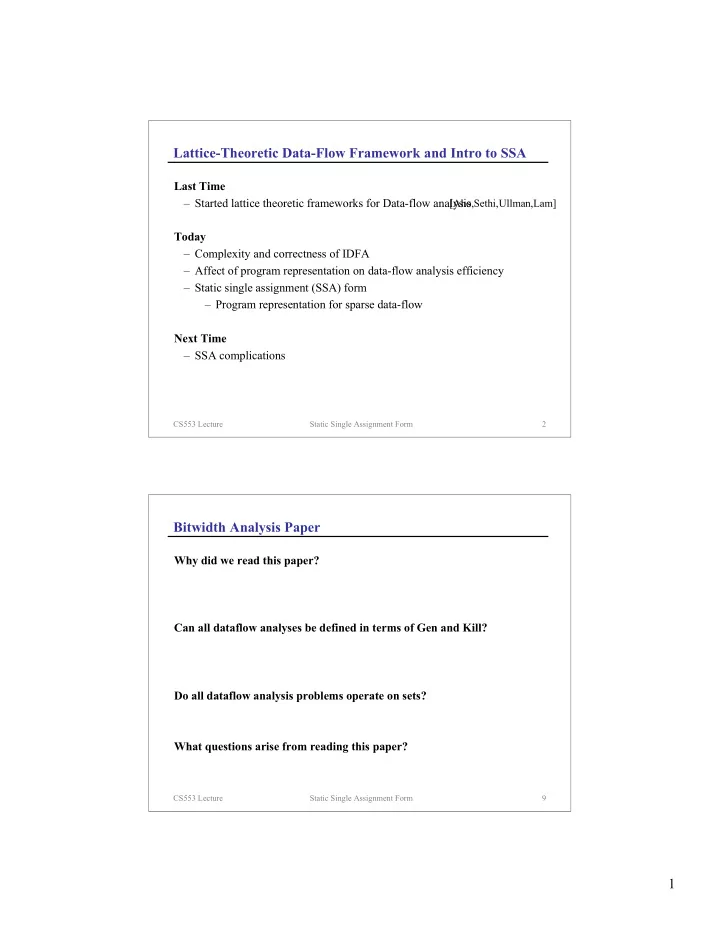

Lattice-Theoretic Data-Flow Framework and Intro to SSA Last Time – Started lattice theoretic frameworks for Data-flow analysis [Aho,Sethi,Ullman,Lam] Today – Complexity and correctness of IDFA – Affect of program representation on data-flow analysis efficiency – Static single assignment (SSA) form – Program representation for sparse data-flow Next Time – SSA complications CS553 Lecture Static Single Assignment Form 2 Bitwidth Analysis Paper Why did we read this paper? Can all dataflow analyses be defined in terms of Gen and Kill? Do all dataflow analysis problems operate on sets? What questions arise from reading this paper? CS553 Lecture Static Single Assignment Form 9 1
Implementing Simple Constant Propagation Standard worklist algorithm – Identifies simple constants – For each program point, maintains one constant value for each variable – O(EV) (E is the number of edges in the CFG; V is number of variables) x = 1 Problem − Inefficient, since constants may have to be propagated through irrelevant nodes y = x Solution − Exploit a sparse dependence representation ( e.g., du-chains, SSA) CS553 Lecture Static Single Assignment Form 10 Data Dependence Definition – Data dependences are constraints on the order in which statements may be executed We say statement s 2 depends on s 1 – Flow (true) dependence : s 1 writes memory that s 2 later reads (RAW) – Anti-dependence : s 1 reads memory that s 2 later writes (WAR) – Output dependences : s 1 writes memory that s 2 later writes (WAW) – Input dependences : s 1 reads memory that s 2 later reads (RAR) True dependences – Flow dependences represent actual flow of data False dependences – Anti- and output dependences reflect reuse of memory, not actual data flow; can often be eliminated CS553 Lecture Static Single Assignment Form 11 2
Example s 1 a = b; flow s 2 b = c + d; anti s 3 e = a + d; output input s 4 b = 3; s 5 f = b * 2; CS553 Lecture Static Single Assignment Form 12 Representing Data Dependences Implicitly – Using variable defs and uses – Pros: simple – Cons: hides data dependence (analyses must find this info) Def-use chains (du chains) – Link each def to its uses – Pros: explicit; therefore fast – Cons: must be computed and updated, space consuming Alternate representations – e.g., Static single assignment form (SSA), dependence flow graphs (DFG), value dependence graphs (VDG) CS553 Lecture Static Single Assignment Form 13 3
DU Chains Definition – du chains link each def to its uses Example s 1 a = b; s 2 b = c + d; du chain s 3 e = a + d; s 4 b = 3; s 5 f = b * 2; CS553 Lecture Static Single Assignment Form 14 UD Chains Definition – ud chains link each use to its defs Example s 1 a = b; s 2 b = c + d; ud chain s 3 e = a + d; s 4 b = 3; s 5 f = b * 2; CS553 Lecture Static Single Assignment Form 15 4
Static Single Assignment (SSA) Form Idea – Each variable has only one static definition – Makes it easier to reason about values instead of variables – Similar to the notion of functional programming Transformation to SSA – Rename each definition – Rename all uses reached by that assignment Example v := ... v 0 := ... ... := ... v ... ... := ... v 0 ... v := ... v 1 := ... ... := ... v ... ... := ... v 1 ... What do we do when there’s control flow? CS553 Lecture Static Single Assignment Form 16 SSA and Control Flow (cont) Merging Definitions – φ -functions merge multiple reaching definitions Example 1 v 0 :=... v 1 :=... 2 3 v 2 := φ (v 0 ,v 1 ) 4 ...v 2 ... CS553 Lecture Static Single Assignment Form 17 5
Another Example v := 1 v 0 := 1 1 1 v := v+1 v 1 := φ (v 0 ,v 2 ) 2 2 v 2 := v 1 +1 CS553 Lecture Static Single Assignment Form 18 SSA vs. ud/du Chains SSA form is more constrained Advantages of SSA – More compact – Some analyses become simpler when each use has only one def – Value merging is explicit – Easier to update and manipulate? Furthermore – Eliminates false dependences (simplifying context) for (i=0; i<n; i++) A[i] = i; Unrelated uses of i are given for (i=0; i<n; i++) different variable names print(foo(i)); CS553 Lecture Static Single Assignment Form 19 6
SSA vs. ud/du Chains (cont) Worst case du-chains? switch (c1) { case 1: x = 1; break; case 2: x = 2; break; case 3: x = 3; break; } x 4 = φ (x 1 , x 2 , x 3 ) switch (c2) { case 1: y1 = x; break; case 2: y2 = x; break; case 3: y3 = x; break; case 4: y4 = x; break; } m defs and n uses leads to m × n du chains CS553 Lecture Static Single Assignment Form 20 Reality Check How can we handle aliasing in SSA? What about backward data-flow analysis problems? How do we transform SSA and generate code from SSA? CS553 Lecture Static Single Assignment Form 21 7
Concepts Lattice-theoretic framework used to prove – Correctness – Complexity – Accuracy Data dependences – Three kinds of data dependences – du-chains Alternate representations – du-chains – SSA Reality check – aliasing? – backward data-flow? – transforming from SSA to code? CS553 Lecture Static Single Assignment Form 22 Next Time Assignments – Schedule for project 2 due Wednesday Lecture – Discuss those SSA reality checks CS553 Lecture Static Single Assignment Form 23 8
Recommend
More recommend